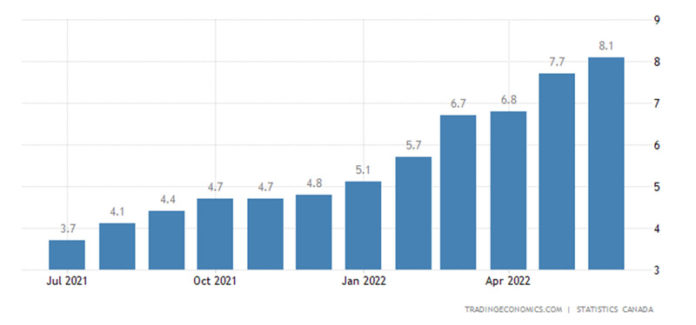Little respite till supplies chains improve and the Ukraine crisis ends. Also there is little chance of recession as people are still spending


Statistics Canada has just announced 8.1% inflation in the month of June, 2022 up from 7.7% in May.
That is the total inflation rate. The core inflation, stripped of food and energy costs has also gone up to 6.2% from 6.1%.
Increases in inflation have been reported all over the world with the Eurozone coming in at 8.6%, the US at 9.1% and the UK at 9.4%.This is creating a headache for all those in charge of reining in inflation. Several economists hold that the interest rate increases all over the world are not enough to moor inflation because they are still at historical lows.
Let us examine Canada. Despite the front-load jumbo increase of 1%(100 basis points) last week by Tiff Macklem, the governor of the Bank of Canada (BoC), many economists say that the overnight rate of 2.5% is low and will not affect inflation, therefore rates should increase further. This has also been reflected in Macklem’s statements.
As mentioned in a previous article, raising rates will only affect the demand side of inflation. The other two main factors, i.e supply chain disruptions because of covid and high energy costs (due to demand and geopolitical tensions such as the Ukraine war) will not be altered.
Macklem himself said on Jul 13 when he raised rates that Canadians are cash rich to the tune of $200 billion plus dollars and consumer spending will continue because of this. He expects inflation to leave a print in the range of 7 plus percentage points for the next few months. Despite knowing this he raised rates, hoping as many mavens think that by doing so, all the excess money will be blown faster after which things will slow down.
As mentioned before Canadians will only stop spending when fatigue sets in. For the time being, having been cooped up due to covid, most want to go out to enjoy and have fun.
As of this writing, the price of WTI oil for the August contract is at about the same levels as before the invasion of Ukraine, around USD 95 per barrel. Some economists believe that the July inflation reading will come in lower than June but still elevated. In February, Canada’s inflation ran at 5.7%. Any reading above this in July will be mostly from the increased demand of goods and services and from supply issues as oil prices have dropped to end Feb levels. Hardly any of it should be attributed to the increase of oil prices due to the Ukraine war.
So once again do not expect the inflation level to come down to the BoC target range of 1-3 % anytime soon. It will be a long and winding tunnel before we see the light of day and hopefully the tunnel doesn’t collapse due to some more geopolitical flashpoints.
The other headache for Global Bank Governors is that rising rates will dampen spending thus leading to a drop in GDP further leading to recession.
The rule of thumb is that two consecutive quarters of negative growth in GDP means a country is in recession. The US has already experienced a negative growth of -1.6% in the first quarter. This fuelled talk of a recession due to the well-oiled propaganda machine of the US .Notice the two negative quarters in the graph below in 2020 when not only the US but the world went through a recession.
The official figure for the second quarter is due at the end of July but the GDPNOW tracker from the Atlanta Fed shows a contraction of 1.6% which technically means a recession. Using the parameters of the US National Bureau of Economic Research such may not be the case, but we will concentrate on the globally accepted parameter as mentioned above.
Here in Canada, we have not yet experienced a negative quarter this year so far. Q1 2002 showed a positive growth of 0.8%. The official figure for Q2 2022 is expected in August but forecasts due to the low unemployment rate of 4.9%(lowest since 1976) higher than expected wage increases, a very positive trade balance of $5.3 billion (highest in 14 years) and several other positive factors show a positive increase in GDP.
Since Macklem has pointed out that he expects strong consumer spending to be the order of the day in the months ahead, nobody is expecting a negative Q3. That leaves the possibility of a contraction in Q4, which would be the first negative growth quarter. If contraction continues in Q1 2023, then we have a recession in the spring of 2023 and not before.
However, that is 9 months in the future and there may be many a slip between the cup and the lip in that time period. So we will cross that bridge when we come to it.
In the meantime bask in the proverbial sun because there is no recession coming soon to Canada.








